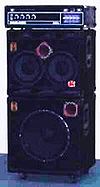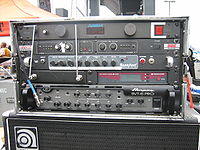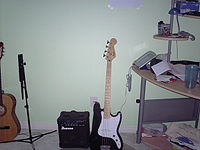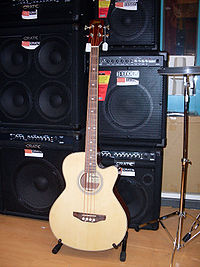
Bass instrument amplification
Encyclopedia

Bass guitar
The bass guitar is a stringed instrument played primarily with the fingers or thumb , or by using a pick....
, double bass
Double bass
The double bass, also called the string bass, upright bass, standup bass or contrabass, is the largest and lowest-pitched bowed string instrument in the modern symphony orchestra, with strings usually tuned to E1, A1, D2 and G2...
and similar instruments, is distinct from other types of amplification systems
Instrument amplifier
An instrument amplifier is an electronic amplifier that converts the often barely audible or purely electronic signal from musical instruments such as an electric guitar, an electric bass, or an electric keyboard into an electronic signal capable of driving a loudspeaker that can be heard by the...
due to the particular challenges associated with low-frequency sound reproduction. This distinction affects the design of the loudspeaker
Loudspeaker
A loudspeaker is an electroacoustic transducer that produces sound in response to an electrical audio signal input. Non-electrical loudspeakers were developed as accessories to telephone systems, but electronic amplification by vacuum tube made loudspeakers more generally useful...
s, the speaker cabinet and the preamplifier and amplifier. Speaker cabinets for bass instrument amplification usually incorporate larger (or more) loudspeakers than the those used for the amplification of other instruments. The loudspeakers themselves must also be sturdier to handle the higher power levels.
Bass instrument speaker cabinets are typically more rigidly constructed and heavily braced than those for non-bass instrument amplification. They usually include tuned bass reflex
Bass reflex
A Bass reflex system is a type of loudspeaker enclosure that uses the sound from the rear side of the diaphragm to increase the efficiency of the system at low frequencies as compared to a typical closed box loudspeaker or an infinite baffle mounting.A reflex port is the distinctive feature of a...
ports or vents for increased efficiency at low frequencies. Preamplifier sections have equalization controls that are designed for the deeper frequency range of bass instruments, and can extend down to 40 Hz or below. Bass instrument amplifiers are more likely to be designed with cooling fans than regular guitar amplifiers, due to the high power demands of bass instrument amplification. They are also more commonly equipped with limiter
Limiter
In electronics, a limiter is a circuit that allows signals below a specified input power to pass unaffected while attenuating the peaks of stronger signals that exceed this input power....
circuitry to prevent overloading the power amplifier and protect the speakers from damage.
1950s–1960s
When the Fender company invented the first widely-produced electric bass guitar (the Fender Precision BassFender Precision Bass
The Fender Precision Bass is an electric bass.Designed by Leo Fender as a prototype in 1950 and brought to market in 1951, the Precision was the first electric bass to earn widespread attention and use. A revolutionary instrument for the time, the Precision Bass has made an immeasurable impact on...
) they also developed a bass amplifier, the Fender Bassman
Fender Bassman
The Fender Bassman was a bass amplifier introduced by Fender in 1952. Although it was originally designed for bass guitars, it was frequently used for normal electric guitar in rock and roll, blues, and country bands.-History:...
, first produced in 1952. This was a 50-watt tube amplifier with a single 15" speaker. In 1954, the Bassman was redesigned to use four 10" speakers. The circuit design also underwent repeated modifications. The "5F6A" circuit introduced in 1959 is widely regarded as a classic amplifier design and was copied by many other manufacturers, such as Marshall.
The Ampeg Bassamp Company, founded in 1949, also produced bass amplifiers that were widely used by electric bass guitarists in the 1950s and 1960s. The first bass amplifier offered by Ampeg
Ampeg
Ampeg is primarily a musical instrument amplifier manufacturer headquartered in Woodinville, Washington, though they also manufacture guitars to a small extent...
was an 18-watt model with a single 12" speaker and a rear ventilation port called the Super 800. In 1951, they introduced a 20-watt version with a 15-inch speaker. In 1960, they introduced the B-15 Portaflex, a flip-top 25-watt bass amplifier with a single 15" speaker. In the late 1960s, the 300-watt Super Vacuum Tube (SVT)
Ampeg SVT
The Ampeg SVT is a bass amplifier made by Ampeg. The SVT, which stands for "Super Valve Technology", was designed by Bill Hughes and introduced in 1969. The SVT bass head produced 300 watts at a time when most amplifiers made less than 100. The SVT has been through many design changes over the...
amplifier head, which was intended for large performance venues. The SVT was intended for use with one or two speaker cabinets containing eight 10" speakers.
In the mid-1960s John Entwistle
John Entwistle
John Alec Entwistle was an English bass guitarist, songwriter, singer, horn player, and film and record producer who was best known as the bass player for the rock band The Who. His aggressive lead sound influenced many rock bass players...
, the bassist for The Who
The Who
The Who are an English rock band formed in 1964 by Roger Daltrey , Pete Townshend , John Entwistle and Keith Moon . They became known for energetic live performances which often included instrument destruction...
, was one of the first major players to make use of Marshall stacks. At a time when most bands used 50 to 100-watt amplifiers with single cabinets, Entwistle used twin stacks with new experimental prototype
Prototype
A prototype is an early sample or model built to test a concept or process or to act as a thing to be replicated or learned from.The word prototype derives from the Greek πρωτότυπον , "primitive form", neutral of πρωτότυπος , "original, primitive", from πρῶτος , "first" and τύπος ,...
200-watt amplifiers. This, in turn, also had a strong influence on the band's contemporaries at the time, with Cream
Cream (band)
Cream were a 1960s British rock supergroup consisting of bassist/vocalist Jack Bruce, guitarist/vocalist Eric Clapton, and drummer Ginger Baker...
and the Jimi Hendrix Experience
The Jimi Hendrix Experience
The Jimi Hendrix Experience were an English-American psychedelic rock band that formed in London in October 1966. Comprising eponymous singer-songwriter and guitarist Jimi Hendrix, bassist and backing vocalist Noel Redding and drummer Mitch Mitchell, the band was active until June 1969, in which...
both following suit. Entwistle also experimented throughout his career with "bi-amplification," where the high and low registers of the bass sound are sent to separate amplifiers and speakers. This allows for more control over the tone, because each register can then be modified (e.g., in terms of tone, added overdrive, etc.) individually. The Versatone Pan-O-Flex amplifier used a different approach to bi-amplification, with separate amplifier sections for bass and treble but a single 12-inch speaker. The Versatone was used by well-known bassists such as Jack Casady
Jack Casady
Jack Casady , is an American musician considered one of the foremost bass guitarists of the rock music era and best known as a member of Jefferson Airplane. First playing as a lead guitarist with the Washington D.C...
and Carol Kaye
Carol Kaye
Carol Kaye is an American musician, best known as one of the most prolific and widely heard bass guitarists in history, playing on an estimated 10,000 recording sessions in a 55 year career....
.
1970s–2000s

As a result of the improvements to PA systems and monitor systems, bass players in the 2000s no longer need to have huge, powerful amplifier systems. Instead, contemporary bass amplifiers usually have preamp-out jacks that can be patched to the PA. In the 2000s, virtually all of the sound reaching the audience in large venues comes from the PA system. As well, in the 2000s on-stage instrument amplifiers are more likely to be kept at a low volume, because high volume levels on stage makes it harder to control the sound mix and produce a clean sound. As a result, in many large venues much of the on-stage sound reaching the musicians now comes from the monitor speakers, not from the instrument amplifiers. Stacks of huge speaker cabinets and amplifiers are still used in concerts in some genres of music, especially heavy metal, but they tend to be used more for the visual effect than for sound reproduction.
Types

For larger venues such as large clubs and outdoor music festivals, or for music genres that use bass instruments with an extended low range (e.g., metal), bass players often use a more powerful amplifier (300 to 1000 watts) and separate speaker cabinets in various combinations.
Separate bass amplifiers, often called 'heads' or 'amp heads' are usually integrated units, with preamplifier and power amplifier combined in a single unit. Some players use separate preamplifer/power amplifier setups, where one or more preamplifiers drive one or more power amplifiers.
Amplifier technology

Solid state (electronics)
Solid-state electronics are those circuits or devices built entirely from solid materials and in which the electrons, or other charge carriers, are confined entirely within the solid material...
(transistor) technology.
Tube amplification
Vacuum tubes were the dominant active electronic components in bass amplifiers manufactured until the early 1970s, and tubes continue to be used for higher-end units. Tube amplifiers for bass almost always use class AB1 topology for efficiency reasons. Many bass players believe that tube amplifiers produce a "warmer" or more "natural" sound than solid state amplifiers when lightly or moderately driven, and more pleasing distortion characteristics when overdriven. Some also believe that they have a greater level of perceived loudness for a given amount of amplifier power. Even though tube amplifiers produce more heat than solid state amplifiers, few manufacturers of tube amplifiers include cooling fans in the amplifiers' chassis. Usually adequate cooling is provided by passive convection. Adequate airflow is needed to prevent excessive heat from shortening the tubes' lifespan or producing tonal inconsistencies.Solid state amplification
By the 1960s and 1970s, semiconductor transistor-based amplifiers began to become popular. This was in large part because solid state amplifiers are less expensive, lighter weight, and require less maintenance than tube amplifiers. In some cases, tube and solid state technologies are used together, usually with a tube preamplifier driving a solid state power amplifier. There are also an increasing range of products that use digital signal processingDigital signal processing
Digital signal processing is concerned with the representation of discrete time signals by a sequence of numbers or symbols and the processing of these signals. Digital signal processing and analog signal processing are subfields of signal processing...
and digital modeling technology to simulate many different combinations of amp and cabinets.
The output transistors of solid state amplifiers can be passively cooled by using metal fins called heat sinks to radiate away the heat. For high-wattage amplifiers, a fan is often used to move air across internal heatsinks. Since transistor bass amplifiers used for large venues need to produce a high output, this usually means that bass amplifiers are very heavy. Most powerful transistorized bass amplifiers use class AB or so-called "push-pull" topology. These need heavy transformers and require large metal heat sinks for cooling. However, Class D amplifiers (also called "switching amplifiers") are more efficient than conventional Class-AB amplifiers, and so are lighter in weight and smaller. The Acoustic Image Focus head, for example, produces 800 watts of power and weighs 2.2 kilograms. Class-D amplifiers use MOSFETs (Metal Oxide Semiconductor Field Effect Transistors) rather than 'ordinary' (bipolar) transistors, and generate a pulse-width modulated signal that is filtered before it reaches the speaker.
Loudspeakers

Loudspeaker
A loudspeaker is an electroacoustic transducer that produces sound in response to an electrical audio signal input. Non-electrical loudspeakers were developed as accessories to telephone systems, but electronic amplification by vacuum tube made loudspeakers more generally useful...
s used for bass guitar amplification are designed around large diameter, heavy-duty drivers, with 10", 12" and 15" being most common. The choice of speaker represents a compromise: while some speakers more effectively reproduce low frequencies, they may have poorer midrange and transient response.
Bassists who want powerful low end may use a subwoofer
Subwoofer
A subwoofer is a woofer, or a complete loudspeaker, which is dedicated to the reproduction of low-pitched audio frequencies known as the "bass". The typical frequency range for a subwoofer is about 20–200 Hz for consumer products, below 100 Hz for professional live sound, and below...
cabinet designed for a PA system. Subwoofers can only produce frequencies up to about 150 or 200 Hz, so a subwoofer cabinet must be paired with a full range speaker to obtain the full tonal range of an electric bass or upright bass.
Cabinet design
Most bass speaker cabinets employ a vented bass-reflexBass reflex
A Bass reflex system is a type of loudspeaker enclosure that uses the sound from the rear side of the diaphragm to increase the efficiency of the system at low frequencies as compared to a typical closed box loudspeaker or an infinite baffle mounting.A reflex port is the distinctive feature of a...
design, which use a port or vent. Others use acoustic suspension
Acoustic suspension
The acoustic suspension woofer is a type of loudspeaker that reduces bass distortion caused by non-linear, stiff mechanical suspensions in conventional loudspeakers...
designs with sealed cabinets; these are relatively uncommon because they tend to be less efficient. Some cabinets use a transmission-line design similar to bass-reflex, and some large cabinets use horn-loading of the woofers.
Tweeters

Tweeter
A tweeter is a loudspeaker designed to produce high audio frequencies, typically from around 2,000 Hz to 20,000 Hz . Some tweeters can manage response up to 65 kHz...
s, typically horn-loaded, are included in some bass instrument speaker cabinets. Vox's 1960s-era "Super Beatle" amplifier was an early enclosure that used horn tweeters. During the late 1960s Acoustic's 260 Series guitar amp used a treble horn in the dual 15" 261 guitar enclosure, and Kustom's nearly 5 feet (1.5 m) 2J + 1H guitar enclosure used two 15" speakers and a 15" diameter treble horn. Horn-equipped cabinets were not available for bass players until much later.
In the early 1980s, some performers began using two-way or three-way cabinets that used 15" woofers, a vented midrange driver and a horn/driver, with a crossover directing the signal to the appropriate driver. Folded horn bass guitar rigs have remained more the exception than the rule due to their size and weight. As well, since the 1990s, most clubs have PA systems with subwoofers that can handle the low range of the bass guitar. Extended range designs with tweeters were more the exception than the rule until the 1990s. The more common use of tweeters in traditional bass guitar amplifiers in the 1990s helped bassists to use effects and perform more soloistic playing styles, which emphasize the higher range of the instrument.
One problem with adding a tweeter to a bass speaker cabinet is that the driver may be damaged by the overdriven amplifier tone that is popular in some musical genres, since overdriving the amplifier adds a great deal of high frequency information to the signal. Horns and speakers in the same cabinet are sometimes wired separately, so that they can be driven by separate amplifiers. Biamplified systems and separately-wired cabinets produced by manufacturers such as Gallien-Krueger
Gallien-Krueger
Gallien-Krueger, also referred to as 'GK' , is an instrument amplifier manufacturer. The company is based in Stockton, California, and was founded in 1968....
and Carvin
Carvin
This article refers to a French commune. For the guitar manufacturer see Carvin Corporation. For the late New Orleans political consultant see Jim Carvin.Carvin is a commune in the Pas-de-Calais department in the Nord-Pas-de-Calais region of France....
allow bassists to send an overdriven sound to the speaker, and a crisp high sound to the horn, which prevents this problem.
Amplifying the double bass

Double bass players playing in genres where a louder amplified tone (emphasizing the fundamental frequencies) is desired for the bass may be more likely to face the problem of feedback. Feedback for double bass generally manifests itself as a sharp, sudden high-volume "howling" sound that can damage loudspeakers. When acoustic instruments with resonant bodies are amplified with microphones and piezoelectric transducer pickups, the common approach used for amplified double basses, they are prone to have feedback problems.
Preamplification and effects
The basic sound of the amplified electric bass or double bass can be modified by electronic bass effects. Preamplifiers, compressionAudio level compression
Dynamic range compression, also called DRC or simply compression reduces the volume of loud sounds or amplifies quiet sounds by narrowing or "compressing" an audio signal's dynamic range...
, limiting, and equalization are the most widely-used effects for bass.
A range of other effects are used in various genres. "Wah-wah" and "synth" bass effects are associated with funk
Funk
Funk is a music genre that originated in the mid-late 1960s when African American musicians blended soul music, jazz and R&B into a rhythmic, danceable new form of music. Funk de-emphasizes melody and harmony and brings a strong rhythmic groove of electric bass and drums to the foreground...
music. As well, since the 1960s and 1970s, bands have experimented with "fuzz bass" where the bass is distorted either by overdriving the amp or by using a distortion
Distortion
A distortion is the alteration of the original shape of an object, image, sound, waveform or other form of information or representation. Distortion is usually unwanted, and often many methods are employed to minimize it in practice...
unit. Octave-generating effects, which generate an octave below the pitch being played are also used by bass players. Many bassists in modern-day hard rock
Hard rock
Hard rock is a loosely defined genre of rock music which has its earliest roots in mid-1960s garage rock, blues rock and psychedelic rock...
and heavy metal
Heavy metal music
Heavy metal is a genre of rock music that developed in the late 1960s and early 1970s, largely in the Midlands of the United Kingdom and the United States...
bands use overdrive pedals made for bass guitar. Well known overdrive effects for bass include the BOSS ODB-3 Bass Overdrive
Boss Corporation
Boss is a manufacturer of effects pedals for electric guitar and bass guitar. It is a division of the Roland Corporation, a Japanese manufacturer that specializes in musical equipment and accessories...
http://www.boss.info/global/gear/261/155, Electro-Harmonix Bass Blogger
Electro-Harmonix
Electro-Harmonix is a New York-based company that makes high-end electronic audio processors. The company was founded by Mike Matthews in 1968. They are most famous for a series of popular guitar effects pedals introduced in the 1970s and 1990s....
http://www.ehx.com/products/bass-blogger/, Tech21 Sansamp Bass Driverhttp://www.tech21nyc.com/products/sansamp/bassdriverdlx.htmlhttp://www.tech21nyc.com/products/sansamp/bassdriverp.html, the DigiTech XBD Bass Driverhttp://www.digitech.com/products/Pedals/BassDriver.php, and the Electro-Harmonix Big Muff
Big Muff
The Big Muff is a fuzzbox produced in New York City by the Electro-Harmonix company, along with their Russian sister company Sovtek, primarily for use with the electric guitar...
.
See also
- Bass effects
- Guitar effects
- Instrument amplifierInstrument amplifierAn instrument amplifier is an electronic amplifier that converts the often barely audible or purely electronic signal from musical instruments such as an electric guitar, an electric bass, or an electric keyboard into an electronic signal capable of driving a loudspeaker that can be heard by the...
- Guitar amplifierGuitar amplifierA guitar amplifier is an electronic amplifier designed to make the signal of an electric or acoustic guitar louder so that it will produce sound through a loudspeaker...
- Guitar speakerGuitar speakerA guitar speaker is a loudspeaker – specifically the driver part – designed for use in or with the guitar amplifier of an electric guitar...
- Isolation cabinet (guitar)Isolation cabinet (guitar)The characteristic sound of a tube guitar amplifier as heard on the majority of professional recordings is achieved by playing the amplifier at high volumes, and using one or more microphones to capture the sound. Turning the volume up causes the pre-amplifier to drive the power amplifier into...
- List of bass amplifier and loudspeaker manufacturers

